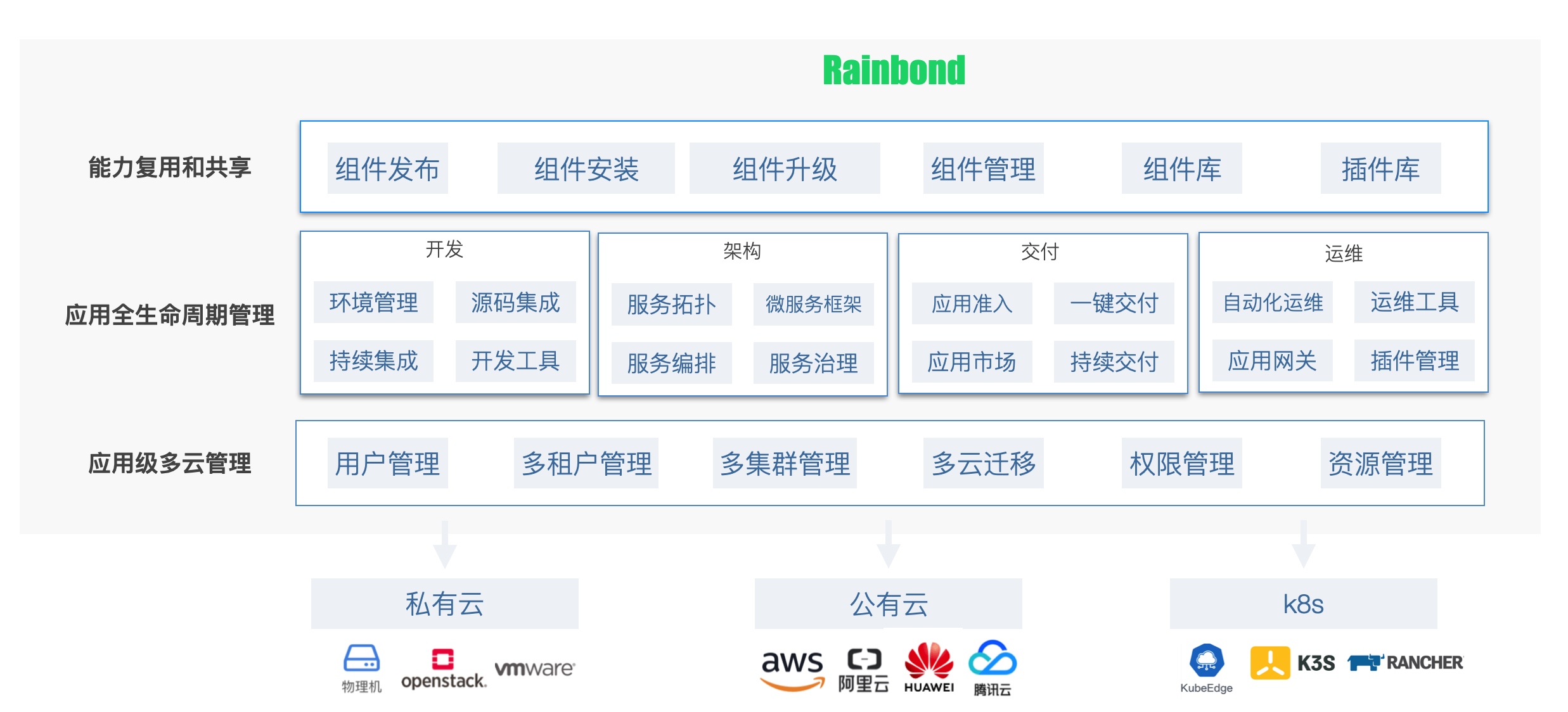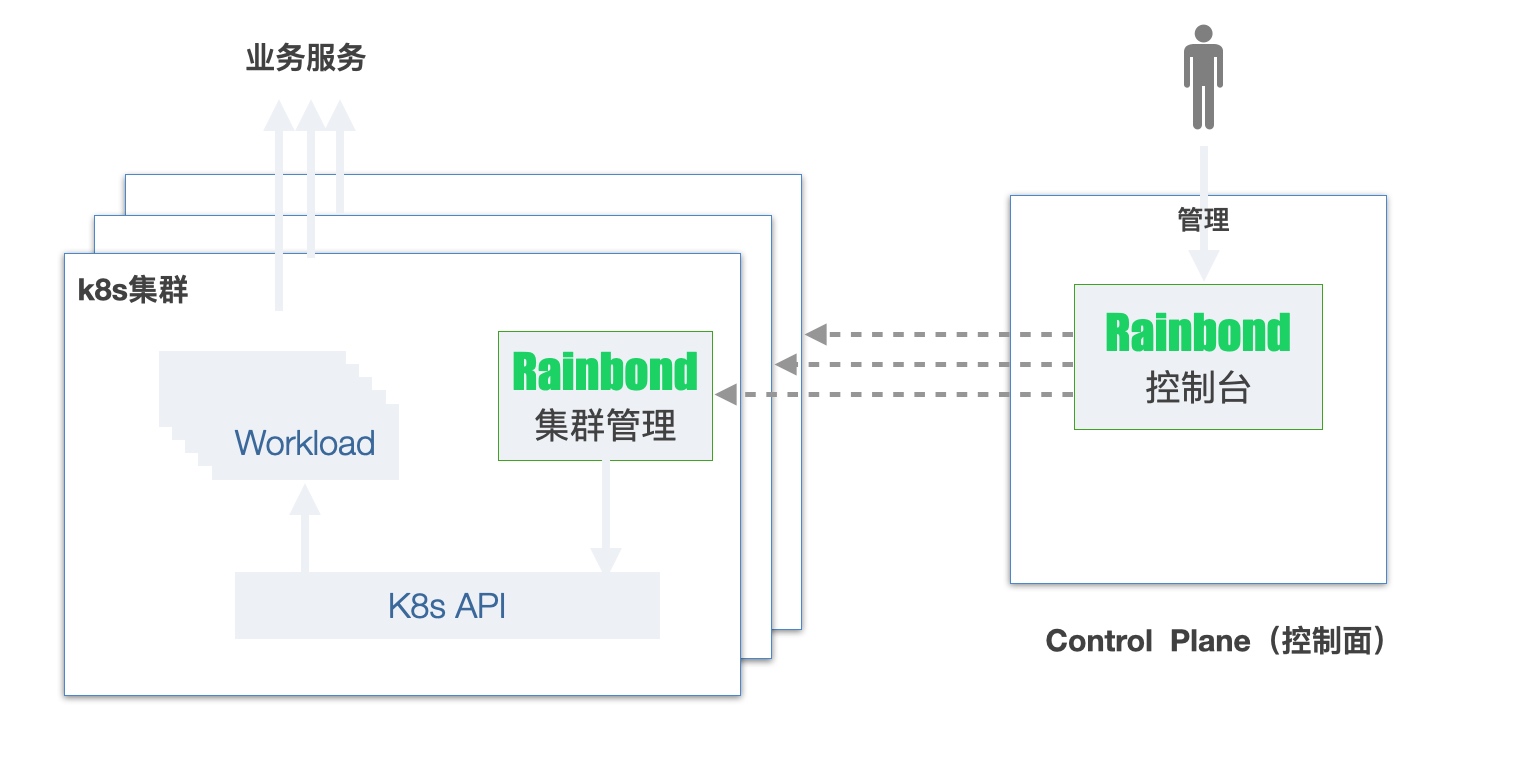Rainbond是什么?
Rainbond 是一款基于 Kubernetes 的云原生应用管理平台, 100% 开源,致力于将复杂的容器编排与应用管理能力转化为简单易用的开发运维体验。无需深入学习 Kubernetes 底层知识,即可通过图形化界面与标准化流程,实现应用的全生命周期管理,适用于企业快速构建云原生应用平台,降低技术门槛与落地成本。
为什么选择Rainbond?
1.使用简单
Rainbond 遵循 以应用为中心 的设计理念,统一封装容器、Kubernetes和底层基础设施相关技术,让使用者专注于业务本身, 避免在业务以外技术上花费大量学习和管理精力。同时,Rainbond 深度整合应用开发、微服务架构、应用交付、应用运维、资源管理,管理高度自动化,实现统一管理所有应用、所有基础设施和所有IT流程。
2.一步将传统应用变成云原生应用
Rainbond 通过“无侵入”技术,让传统应用不需要改动或少量改动就能快速变成云原生应用。 传统应用转成成云原生应用的方式:
- 有源代码和软件包的应用,平台自动识别开发语言类型和包类型,不改变开发者习惯,代码直接编译、构建成支持云原生特性的应用。
- 对于想实现微服务架构的传统应用,Rainbond提供Service Mesh 微服务架构,应用不改代码就能变成微服务架构。
- 传统应用想要扩展运维和治理功能,Rainbond提供“无侵入”的插件,按需加载插件,开启运维和服务治理能力。
3.实现数字化能力积累和复用
Rainbond能将企业内部各种数字化能力一键发布成组件,并具备组件安装使用、组件编排、组件版本管理、组件升级和持续迭代等完整的管理流程,将企业内部可复用的能力积累到组件库,既避免重复建设,还能将这些组件变成数字资产,为企业创新提供动力。
4.解决2B行业的交付问题,实现各种交付流程自动化
Rainbond提供企业应用的业务集成、多云交付、私有交付、SaaS交付、离线交付、个性化交付、应用市场等能力,将交付过程最大限度自动化,提高企业应用交付效率,降低交付成本。
与其他产品差异
| Rainbond | Rancher | KubeSphere | |
|---|---|---|---|
| 核心定位 | 应用级PaaS,应用抽象与交付,无需学习 Kubernetes 的容器平台 | Kubernetes管理平台,多集群管理与运维 | 分布式操作系统,全栈容器化解决方案 |
| 面向用户 | 开发者、应用运维人员、企业IT人员 (尤其是不熟悉K8s的团队) | K8s管理员、平台运维团队 | K8s管理员、DevOps工程师、有K8s经验的开发者 |
| 与K8s关系 | 高度抽象K8s,用户无需感知K8s细节;可纳管已有K8s或一键安装K8s(可跑在Rancher之上) | 管理和编排K8s集群 (有自己的发行版本RKE和K3s) | K8s之上的扩展各种能力 快速安装K8s集群,也可纳管其他K8s集群 |
| 核心价值 | 极简应用管理:源码/软件包/镜像直接部署,应用级运维 软件资产化:应用模版化,一键交付与复用 业务连续性:无感知升级、回滚 低门槛:无需K8s经验 | 多集群统一管理:跨云、跨数据中心 简化K8s运维:监控、告警、日志、安全 生态整合:丰富的应用商店 (Helm) | 全栈能力:整合DevOps、服务网格、可观测等工具 一致的用户体验:友好的UI 即插即用架构:灵活扩展 |
| 学习曲线 | 低:专注于应用本身,模版扩展能力 | 中:需理解K8s集群管理 | 中高:需理解K8s及相关生态组件 |
| 适用场景 |
|
|
|
Rainbond的功能及架构

应用级多云管理
应用级强调以“应用”为中心,跟应用相关技术概念对外暴露,跟应用不直接相关的技术概念统一包装,底层的基础设施通过软件定义系列技术(SDN、SDS、SD-WAN、docker、LB)包装,把底层重复性工作实行实行自动化,并在应用抽象之上支撑应用的开发、架构、交付和运维,这种抽象粒度,即能简化应用的管理,又能满足业务的灵活性。
多云管理的核心是将应用和计算资源解耦,根据场景任意组合,可以实现混合云、边缘云、应用级多云,应用的生命周期管理跟计算资源不直接相关,也就是说应用的开发可以在任何类型的计算资源上,开发好的应用可以直接安装运行在任何类型的计算资源上,还可以随时从一种云迁移到另一种云,应用不用做任何改动。
应用全生命周期管理
应用全生命周期管理包括应用开发、微服务架构、应用交付和应用运维。
- 开发阶段,Rainbond提供开箱即用的开发测试环境,对接各类源代码仓库,自动识别开发语言并编译构建和打包,通过应用市场安装各种开发工具。
- 架构阶段,支持各种常见微服务架构,业务服务可以模块化编排,通过服务拓扑可视化了解业务的结构和依赖关系,通过插件扩展各种服务治理能力。
- 交付阶段,支持应用持续交付流程,开发的应用以应用模版的形式存放到应用市场,通过应用市场对应用展示和分类,对于联网的用户,远程连接应用市场,一键安装和升级。对于离线用户,从应用市场导出离线应用包,到用户环境导入离线应用包,一键安装和运行。
- 运维阶段,把所有��应用运维工作通过web界面呈现,除了基本的应用管理(启动、关闭、重启、删除)操作外,主要的运维过程都是自动化的,提供可观测性深入了解自动化的执行过程。面对大数据和大用户的应用场景,支持业务快速伸缩,及时响应业务的变化。
能力复用和共享
组件是独立运行、可复用、可扩展、可集成的单元,支持不同的粒度大小,支持版本管理,组件可以在不同应用场景中复用,组件自身可以迭代升级,积累的组件统一存放到组件库,当有应用需要使用组件时,只需通过“拖拉拽”的方式快速拼装,当积累的组件越多,交付应用的速度也越快。
Rainbond怎么工作?

Rainbond主要有两部分组成,一个是提供Web界面的Rainbond控制台,另一个是安装在K8s集群内部的Rainbond集群管理端。
Rainbond控制台提供控制面的监控和管理,主要服务开发人员和管理人员,控制台通过Rainbond集群管理端提供的API来管理K8s集群和运行在K8s集群上的应用,并把元数据存储在本地,控制台关闭不影响K8s集群和业务服务的运行。一个控制台能监控和管理多个K8s集群。
Rainbond集群管理端通过控制台或Helm方式安装到一个或多个K8s集群内,由它对接标准K8s API,控制台的监控和管理指令通过调用K8s API实现,通过控制台部署的应用,也可以使用K8s的命令查看和管理。